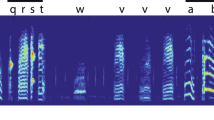Abstract
The singing behavior of songbirds has been investigated as a model of sequence learning and production. The song of the Bengalese finch, Lonchura striata var. domestica, is well described by a finite state automaton including a stochastic transition of the note sequence, which can be regarded as a higher-order Markov process. Focusing on the neural structure of songbirds, we propose a neural network model that generates higher-order Markov processes. The neurons in the robust nucleus of the archistriatum (RA) encode each note; they are activated by RA-projecting neurons in the HVC (used as a proper name). We hypothesize that the same note included in different chunks is encoded by distinct RA-projecting neuron groups. From this assumption, the output sequence of RA is a higher-order Markov process, even though the RA-projecting neurons in the HVC fire on first-order Markov processes. We developed a neural network model of the local circuits in the HVC that explains the mechanism by which RA-projecting neurons transit stochastically on first-order Markov processes. Numerical simulation showed that this model can generate first-order Markov process song sequences.
Similar content being viewed by others
References
Abarbanel HDI, Gibb L, Huerta R, Rabinovich MI and Talathi S (2004). Spike timing and synaptic plasticity in the premotor pathway of birdsong. Biol Cybern 91: 159–167
Chatfield C (2004). Analysing sequences of behavioural events. J Theor Biol 29: 427–445
Doya K and Sejnowski TJ (1995). A novel reinforcement model of birdsong vocalization learning. Adv Neural Inf Process Syst 7: 101–108
Drew PJ and Abbott LF (2003). Model of song selectivity and sequence generation in area HVc of the songbird. J Neurophysiol 89: 2697–2706
Fee MS, Kozhevnikov AA and Hahnloser RH (2004). Neural mechanisms of vocal sequence generation in the songbird. Ann N Y Acad Sci 1016: 153–170
Dutar P, Vu HM and Perkel DJ (1998). Multiple cell types distinguished by physiological, pharmacological, and anatomic properties in nucleus HVc of the adult zebra finch. J Neurophysiol 80: 1828–1838
Hahnloser RH, Kozhevnikov AA and Fee MS (2002). An ultra-sparse code underlies the generation of neural sequences in songbird. Nature 419: 65–70
Hosino T and Okanoya K (2000). Lesion of a higher-order song nucleus disrupts phrase level complexity in Bengalese finches. Neuroreport 11: 2091–2095
Jin DZ, Ramazanoğlu FM, Seung HS (2007) Intrinsic bursting enhances the robustness of a neural network model of sequence generation by avian brain area HVC. J Comput Neurosci (in press)
Kozhevnikov AA, Fee MS (2007) Singing-related activity of identified HVC neurons in the zebra finch. J Neurophysiol (in press)
Katahira K, Kawamura M, Okanoya K and Okada M (2007). Retrieval of branching sequences in an associative memory model with common external input and bias input. J Phys Soc Jpn 76: 044804
Li M and Greenside H (2006). Stable propagation of a burst through a one-dimensional homogeneous excitatory chain model of songbird nucleus HVC. Phys Rev E 74: 011918
Leonardo A and Fee MS (2005). Ensemble coding of vocal control in birdsong. J Neurosci 25: 652–661
Mooney R and Prather J (2005). The HVC microcircuit: the synaptic basis for interactions between song motor and vocal plasticity pathways. J Neurosci 25: 1952–1964
Okanoya K (2004a). Bengalese finches: A window to the neurobiology of birdsong syntax. Ann N Y Acad Sci 1016: 724–735
Okanoya K (2004b). Proximate and ultimate studies of song complexity in Bengalese finches. Adv Study Behav 34: 297–346
Sakata J and Brainard MS (2006). Real-time contributions of auditory feedback to avian vocal motor control. J Neurosci 26: 9619–9628
Schmidt MF (2003). Pattern of interhemispheric synchronization in HVc during singing correlates with key transitions in the song pattern. J Neurophysiol 90: 3931–3949
Troyer TW and Doupe AJ (2000). An associational model of birdsong sensorimotor learning II. Temporal hierarchies and the learning of song sequence. J Neurophysiol 84: 1224–1239
Uno H, Okanoya K (1998) Neural basis for song production in Bengalese finches: effects of partial lesions on the higher vocal center (in Japanese). Tech Report IEICE SP97:137
Vu ET, Mazurek ME and Kuo YC (1994). Identification of a forebrain motor programming network for the learned song of zebra finches. J Neurosci 14: 6924–6934
Wang XJ (1999). Synaptic basis of cortical persistent activity: the importance of NMDA receptors to working memory. J Neurosci 18: 9587–9603
Author information
Authors and Affiliations
Corresponding author
Rights and permissions
About this article
Cite this article
Katahira, K., Okanoya, K. & Okada, M. A neural network model for generating complex birdsong syntax. Biol Cybern 97, 441–448 (2007). https://doi.org/10.1007/s00422-007-0184-y
Received:
Accepted:
Published:
Issue Date:
DOI: https://doi.org/10.1007/s00422-007-0184-y




